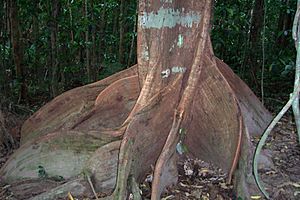Spur mahogany facts for kids
Quick facts for kids Spurwood |
|
|---|---|
 |
|
| Daintree National Park, Australia | |
| Scientific classification | |
| Genus: |
Dysoxylum
|
| Species: |
pettigrewianum
|
The Spurwood (scientific name: Dysoxylum pettigrewianum) is a very large tree that grows in tropical rainforests. It belongs to the Meliaceae family, which also includes mahogany trees. You can find the Spurwood in places like Queensland (Australia), New Guinea, the Solomon Islands, and Malesia. In Queensland, it grows in the wet tropical areas, from Cooktown in the north down to Tully.
Contents
Discovering the Spurwood
This amazing tree was first officially described in 1892. It was named by Frederick Manson Bailey, a botanist who studied plants in Queensland. The name pettigrewianum honors a person named William Pettigrew. Besides "Spurwood," people sometimes call it "Cairns satinwood" or "spur mahogany." It's part of a big group of tropical trees called Dysoxylum, and many of them are huge rainforest trees.
What Does a Spurwood Tree Look Like?
Spurwood trees are famous for the unique bumps or "spurs" that stick out from the bottom of their trunks. These spurs are part of the tree's buttresses, which help support its massive size. A Spurwood can grow taller than 35 meters (about 100 feet)! That's like a ten-story building! Its wide top, called a canopy, can spread out up to 15 meters (50 feet).
The bark of the Spurwood tree is dark brown and feels a bit bumpy. The wood inside is reddish-brown and has a nice smell. Its leaves are made up of 7 to 15 smaller leaflets that overlap each other. Sometimes, if the weather gets dry in winter, the tree might lose its leaves.
Flowers and Fruit
In January, small yellow flowers appear on the Spurwood tree. They are shaped like bells and are about 1.2 centimeters (half an inch) wide. After the flowers, the tree grows pear-shaped fruits. These fruits ripen in November and each one holds four seeds.
The fruits are orange-brown and also have a bumpy surface. Many rainforest animals enjoy eating them! For example, large birds called cassowaries and metallic starlings love to snack on the fruits. The leaves of the Spurwood are also a favorite food for Lumholtz's tree-kangaroo.
Where Spurwood Trees Grow and How They Are Used
Spurwood trees prefer to grow in lowland rainforests. They can be found at elevations up to 800 meters (about 2500 feet) above sea level.
Because they grow so big, Spurwood trees are not usually planted in small home gardens. However, they are perfect for large parks and public gardens. They make excellent shade trees, providing a cool spot on sunny days. Young Spurwood plants need some protection when they are first growing. They grow best in soil that drains well and is a bit acidic.

